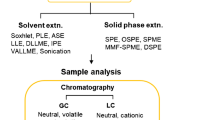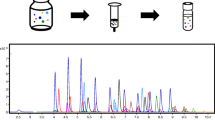Abstract
New psychoactive substances (NPS)—such as synthetic cathinones and piperazines—are defined as substances designed to replicate the effects of traditional illegal drugs, including cocaine, ecstasy and amphetamines. These substances are known to potentially be much more potent than their analogs. In the past, there were many poisonings and deaths associated with NPS. Because of this, NPS identification and quantification have become more important in forensic toxicology. The present work aimed to develop, validate and apply a liquid chromatography-tandem mass spectrometry (LC-MS/MS) method capable of detecting 35 synthetic cathinones and piperazines in hair samples. All target analytes were resolved in a 12 min run time and identified based on the quantifier ion, at least one product ion and the retention time. Depending on the analyte, the calibration curves were linear over a maximal range of 0.01–3 ng/mg. The limits of detection and quantification were within the ranges of 0.006–0.052 ng/mg and 0.008–0.095 ng/mg, respectively. The precision, bias and matrix effect were all within acceptable GTFCh thresholds and the method was free from interferences. The validated method was successfully used to identify synthetic cathinones and piperazines in authentic hair samples (n = 40) from forensic cases, demonstrating its suitability for the screening and quantification of a wide number of new stimulants in hair specimens.

Similar content being viewed by others
References
European Monitoring Centre for Drugs and Drug Addiction. European drug report (2018): Trends and developments. Publications office of the European Union, Luxembourg 2018. http://www.emcdda.europa.eu/publications/edr/trends-developments/2018_en.
Kacinko SL, Papsun DM. The evolving landscape of designer drugs. In: Langman LJ, Snozek CLH, editors. LC-MS in drug analysis: methods and protocols. New York: Springer New York; 2019. p. 129–35.
Smith JP, Sutcliffe OB, Banks CE. An overview of recent developments in the analytical detection of new psychoactive substances (NPSs). Analyst. 2015;140:4932–48.
Valente MJ, Guedes de Pinho P, de Lourdes Bastos M, Carvalho F, Carvalho M. Khat and synthetic cathinones: a review. Arch Toxicol. 2014;88:15–45.
Gautam L, Shanmuganathan A, Cole MD. Forensic analysis of cathinones. Forensic Sci Rev. 2013;25:47–64.
Cozzi NV, Sievert MK, Shulgin AT, Jacob P 3rd, Ruoho AE. Inhibition of plasma membrane monoamine transporters by beta-ketoamphetamines. Eur J Pharmacol. 1999;381:63–9.
Kehr J, Ichinose F, Yoshitake S, Goiny M, Sievertsson T, Nyberg F, et al. Mephedrone, compared with MDMA (ecstasy) and amphetamine, rapidly increases both dopamine and 5-HT levels in nucleus accumbens of awake rats. Br J Pharmacol. 2011;164:1949–58.
Al BJ, Tuv S, Røed Bilgrei O, Fjeld B, Bachs L. Synthetic cannabinoids and cathinones: prevalence and markets. Forensic Sci Rev. 2013;25:7–26.
Alvarez JC, Fabresse N, Larabi IA. Prevalence and surveillance of synthetic cathinones use by hair analysis: an update review. Curr Pharm Des. 2017;23:5487–95.
Prosser JM, Nelson LS. The toxicology of bath salts: a review of synthetic cathinones. J Med Toxicol. 2012;8:33–42.
Margasińska-Olejak J, Celiński R, Fischer A, Stojko J. A fatal case of poisoning of a 19-year-old after taking 3-MMC. Forensic Sci Int. 2019;300:e34–7.
Pragst F, Balikova M. State of the art in hair analysis for detection of drug and alcohol abuse. Clin Chim Acta. 2006;370:17–49.
Krumbiegel F, Hastedt M, Westendorf L, Niebel A, Methling M, Parr MK, et al. The use of nails as an alternative matrix for the long-term detection of previous drug intake: validation of sensitive UHPLC-MS/MS methods for the quantification of 76 substances and comparison of analytical results for drugs in nail and hair samples. Forensic Sci Med Pathol. 2016;12:416–34.
Carlier J, Diao X, Scheidweiler KB, Huestis MA. Distinguishing intake of new synthetic cannabinoids ADB-PINACA and 5F-ADB-PINACA with human hepatocyte metabolites and high-resolution mass spectrometry. Clin Chem. 2017;63:1008–21.
Broecker S, Herre S, Pragst F. General unknown screening in hair by liquid chromatography-hybrid quadrupole time-of-flight mass spectrometry (LC-QTOF-MS). Forensic Sci Int. 2012;218:68–81.
Peters FT, Hartung M, Herbold M, Schmitt G, Daldrup T, Mußhoff F. Requirements for the validation of analytical methods, Appendix B. In: Guideline for quality assurance in forensic-toxicological analyses. English translation, original German version published in Toxichem Krimtech. 2009;76:185–208.
Valistat 2.0. Excel program for the validation according to the guidelines of the GTFCh in consideration of ISO 5725. https://www.arvecon.com/soft/index.html. Accessed 17 Jun 2019.
Matuszewski BK, Constanzer ML, Chavez-Eng CM. Strategies for the assessment of matrix effect in quantitative bioanalytical methods based on HPLC-MS/MS. Anal Chem. 2003;75:3019–30.
Kyriakou C, Pellegrini M, Garcia-Algar O, Marinelli E, Zaami S. Recent trends in analytical methods to determine new psychoactive substances in hair. Curr Neuropharmacol. 2017;15:663–81.
Salomone A, Palamar JJ, Gerace E, Di Corcia D, Vincenti M. Hair testing for drugs of abuse and new psychoactive substances in a high-risk population. J Anal Toxicol. 2017;41:376–81.
Kintz P. Evidence of 2 populations of mephedrone abusers by hair testing. Application to 4 forensic expertises. Curr Neuropharmacol. 2017;15:658–62.
Freni F, Bianco S, Vignali C, Groppi A, Moretti M, Osculati AMM, et al. A multi-analyte LC-MS/MS method for screening and quantification of 16 synthetic cathinones in hair: application to postmortem cases. Forensic Sci Int. 2019;298:115–20.
Sporkert F, Pragst F, Bachus R, Masuhr F, Harms L. Determination of cathinone, cathine and norephedrine in hair of Yemenite khat chewers. Forensic Sci Int. 2003;133:39–46.
Larabi IA, Martin M, Etting I, Penot P, Fabresse N, Alvarez JC. Drug-facilitated sexual assault (DFSA) involving 4-methylethcathinone (4-MEC), 3,4-Methylenedioxypyrovalerone (MDPV), and doxylamine highlighted by hair analysis. Drug Test Anal. 2018;10:1280–4.
Alvarez JC, Etting I, Abe E, Villa A, Fabresse N. Identification and quantification of 4-methylethcathinone (4-MEC) and 3,4-methylenedioxypyrovalerone (MDPV) in hair by LC-MS/MS after chronic administration. Forensic Sci Int. 2017;270:39–45.
Evans EA, Sullivan MA. Abuse and misuse of antidepressants. Subst Abus Rehabil. 2014;5:107–20.
Ramirez Fernandez MD, Wille SM, Hill V, Samyn N. Determination of antidepressants in hair via UHPLC-MS/MS as a complementary informative tool for clinical and forensic toxicological assessments. Ther Drug Monit. 2016;38:751–60.
Salomone A, Gazzilli G, Di Corcia D, Gerace E, Vincenti M. Determination of cathinones and other stimulant, psychedelic, and dissociative designer drugs in real hair samples. Anal Bioanal Chem. 2015;408:2035–42.
Boumba VA, Di Rago M, Peka M, Drummer OH, Gerostamoulos D. The analysis of 132 novel psychoactive substances in human hair using a single step extraction by tandem LC/MS. Forensic Sci Int. 2017;279:192–202.
Cooper GA, Kronstrand R, Kintz P. Society of hair testing guidelines for drug testing in hair. Forensic Sci Int. 2012;218:20–4.
Acknowledgments
The authors would like to thank Mrs. Charlott Gustloff for her practical support in the laboratory during method validation. Furthermore, we would like to thank Mr. Stefan Scholtis from the Governmental Institute of Legal Medicine and Forensic Sciences for the provision of some NPS positive hair samples. We also thank the German Federation against Alcohol and Drugs in Road Traffic (B.A.D.S.; Bund gegen Alkohol und Drogen im Straßenverkehr e.V.) for their independent financial support.
Author information
Authors and Affiliations
Corresponding author
Ethics declarations
Conflict of interest
The authors declare that they have no conflict of interest.
Additional information
Publisher’s note
Springer Nature remains neutral with regard to jurisdictional claims in published maps and institutional affiliations.
Rights and permissions
About this article
Cite this article
Niebel, A., Krumbiegel, F., Hartwig, S. et al. Detection and quantification of synthetic cathinones and selected piperazines in hair by LC-MS/MS. Forensic Sci Med Pathol 16, 32–42 (2020). https://doi.org/10.1007/s12024-019-00209-z
Accepted:
Published:
Issue Date:
DOI: https://doi.org/10.1007/s12024-019-00209-z




